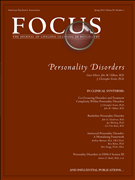From the Guest Editors
Personality disorders (PDs) have been identified in every edition of the Diagnostic and Statistical Manual (DSM) of the American Psychiatric Association (APA). Specific diagnostic criteria were identified to define each of the PDs in 1980 in DSM-III, and the PDs were placed on Axis II in this first multiaxial version of the DSM. It is interesting that the two main diagnostic categories on Axis II were the PDs and, so called at the time, mental retardation. Although placement of these two groups on Axis II was multidetermined, it is easy to imagine that they were both seen as “life sentences”—one thought to be “psychogenic” and the other “biological” and heritable but both being longstanding and unlikely to change. We know now that some of these distinctions and assumptions are inaccurate. The PDs are moderately heritable conditions, comparably so to such disorders as major depression and schizophrenia. As is true in all of medicine, the combination of heritable risk and environmental stress can lead to the development of an illness, a formula that applies to the PDs as well as to other psychiatric disorders. The PDs generally have their onset in late adolescence or early adulthood, and it is often early life trauma or neglect that impairs the normal attachment process, thus interfering with the development of a healthy sense of self and of healthy and mutually rewarding interpersonal relationships.
One advantage of the DSM-III multiaxial system and diagnostic criteria was to encourage clinicians to make multiaxial diagnoses, including the presence or absence of an Axis II PD in all adult patients. Personality research has increased exponentially, and new findings about personality, personality disorders, and Axis I/Axis II comorbidity have proliferated. One theme of this research has been a widely endorsed view that personality and personality disorders are best conceptualized dimensionally, rather than categorically. The DSM-5 Personality and Personality Disorders Work Group developed a new model for the PDs that minimized redundant categories, introduced criteria based on dimensional traits, and reframed the core definition of any PD as moderate or greater impairment in functioning in a sense of self (identity) and in interpersonal relationships. The APA chose to retain the DSM-IV-TR content for the main DSM-5 PD diagnostic system, but the proposal by the Work Group is included in Section III as an “Alternative DSM-5 Model for Personality Disorders,” for further study.
In this special issue of FOCUS, we have selected outstanding leaders in the personality and personality disorder field to present the latest research findings and clinical wisdom in this developing field. We are confident that you will find it informative and clinically relevant.



